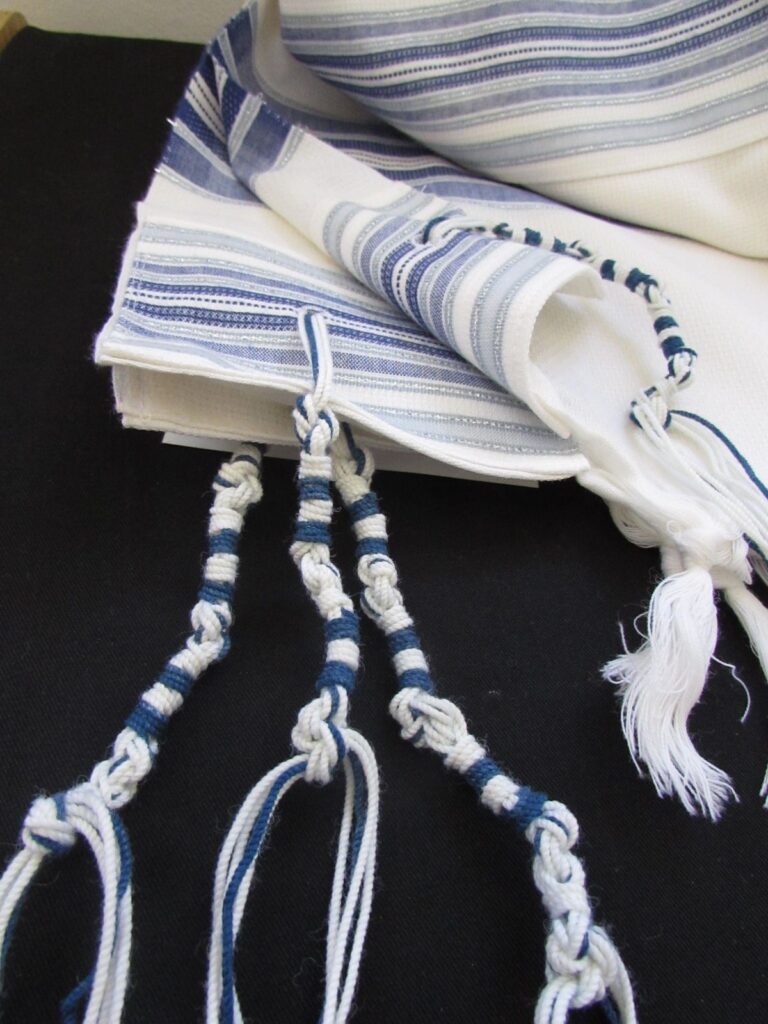 By Doreen Bornfreund, WLCJ International Vice President and Membership Chair
By Doreen Bornfreund, WLCJ International Vice President and Membership Chair
Sh’lach – Numbers 13:1 – 15:41
Adonai said to Moses: Instruct them (the children of Israel) to make for themselves fringes (tzizit) on the corners of their garments. (Numbers 15:37 & 38)
This garment, with fringes, has evolved into the tallit. Tallit is an Aramaic word from the root word meaning cover. Tallit literally means cloak or sheet but in Talmudic times already referred to the Jewish prayer shawl. When I read “the children of Israel,” I understand that all people are instructed to wear tallit.
 What do the Rabbis say, you ask? In the Talmud, the Rabbis taught that all are obligated in the laws of tzitzit: priests, Levites, and Israelites, converts, women, and slaves.
What do the Rabbis say, you ask? In the Talmud, the Rabbis taught that all are obligated in the laws of tzitzit: priests, Levites, and Israelites, converts, women, and slaves.
One 2nd century sage, Rabbi Judah, used to attach blue-dyed fringes to the aprons of the women of his household. Rabbi Shimon exempts women because it is a time-bound positive commandment, which generally women are exempt from. It is often noted that Michal, the daughter of Saul, wife of David, wore tefillin and the sages did not object. Rabbi Abraham Danzig said, “If they want to wear tzitzit and make the blessing, they may recite the blessing.” Rabbi Moshe Feinstein agreed, but suggested that a woman who wishes to wear a tallit must wear a distinctly feminine one, as a way for a woman to fulfill this mitzvah while recognizing that they are not required to do so.
In Deuteronomy 22:5, it reads: A woman must not put on man’s apparel, nor shall a man wear woman’s clothing, for whoever does these things is abhorrent to you God (Adonai).
Until I went shopping for a tallit, I did not realize that a woman’s tallit is different from that of a man’s tallit. Now I know why!
Off and on, back and forth, and “no, not yet,” between 2006 and 2020, I shopped for a tallit. From 2006 in our synagogue on Sukkot, as outgoing Sisterhood President, when I had an aliyah for the first time ever, through my Adult Bat Mitzvah graduation, and my 70th birthday, and Rosh Hashanah 2019, every time, as I was excited and exhilarated to fulfill this mitzvah, I was inwardly disappointed that I had to use a designated cloth to touch the Torah. The blue velvet cloth. This feeling stayed with me over the years.
Then, like our ancestors before us, we experienced a plague. During the Pandemic, I was thankful for Zoom and WLCJ daily study sessions. I got involved with attending Women of the Wall Rosh Chodesh services, first on Zoom, later watching livestream on Facebook. I wrapped myself in a shawl, just me and my computer, at midnight, eastern time. I loved the feeling. I enjoyed the joy and singing of these inspiring women.
Having watched my involvement, a month before my birthday in 2022, my husband, who was brought up Orthodox, suggested I order the tallit from Women of the Wall as my gift from him. I was stunned. He chose the “Garden of Eden Tallit” as his preference. Luckily, it was also my choice! Finally, at shul for my birthday aliyah, I wrapped my tallit around myself. No more blue velvet cloth!
A bit more of my story. My reluctance to purchase and wear a tallit also stemmed from my belief that I felt like an imposter. My reading of Hebrew is very slow, I can’t lead prayer services, I’m tone deaf, and I don’t dare to sing out loud. When I needed to say blessings as a Sisterhood President, I memorized them or read them from transliteration. I felt that I lacked what I believed were the essentials to merit this mitzvah.
Why now? These aspects of my being haven’t changed. But I now realize there are other qualities that are just as valuable. I took stock of myself and I learned that perfection is not necessary. What is important is to do what you can do as best you can. To wear my tallit because I feel the blessing of Adonai wrap around me feels so right. It gives me the strength to be who I want to be.
Women may not be obligated to wear tallit but they are certainly not forbidden from doing so. Women from all around the world attend Rosh Chodesh services, with Women of the Wall, at the Kotel, in person, and by livestream. The women leading these services wear the tallit available for purchase on the Women of the Wall website. By purchasing and wearing these tallitot, from outside of Israel and from within, women are expressing their desire for this practice, of women davening at the Western Wall, be accepted.
Wearing a tallit is a reminder of what we have been commanded by Adonai to do as children of Israel, a reminder of our place as women within the Jewish Community. When I have an aliyah this Shabbat, in honor of the 54th yartzeit of my father, z”l, I will wear my tallit proudly.
Shabbat Shalom,
Doreen Bornfreund
WLCJ International Vice President and Membership Chair
dbornfreund@wlcj.org








